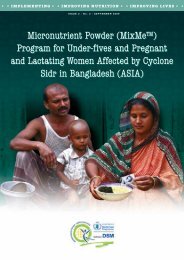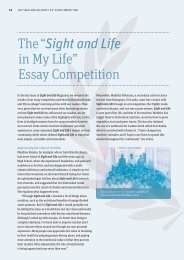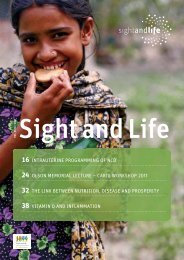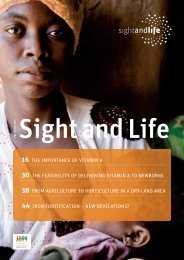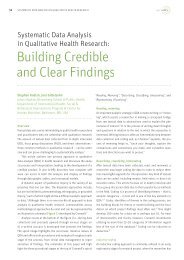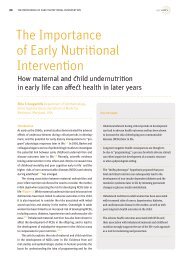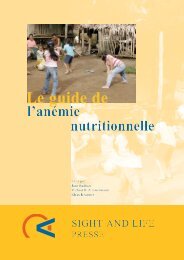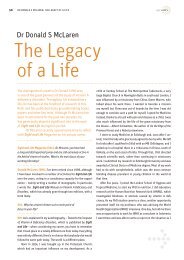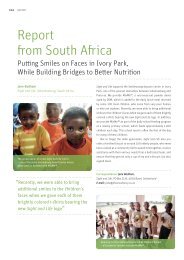Newsletter 02 2006.pdf - Sight and Life
Newsletter 02 2006.pdf - Sight and Life
Newsletter 02 2006.pdf - Sight and Life
You also want an ePaper? Increase the reach of your titles
YUMPU automatically turns print PDFs into web optimized ePapers that Google loves.
NEWSLETTER 2/2006<br />
51<br />
SIGHT AND LIFE<br />
Publications<br />
SIGHT AND LIFE presents recent publications which may be of particular interest to our readers.<br />
However, these publications are not available from SIGHT AND LIFE, nor do we have any privileged<br />
access to them.<br />
Food <strong>and</strong> Nutrition: a<br />
H<strong>and</strong>book for Namibian<br />
Volunteer Leaders<br />
The Government of the Republic<br />
of Namibia (GRN), through the<br />
Technical Co-operation Program<br />
(TCP) of the Food <strong>and</strong> Agriculture<br />
Organization of the United Nations<br />
(FAO), launched a new program<br />
called Rural Youth Clubs of<br />
Namibia (RYCN), as an outreach<br />
for the Rural Youth Development<br />
Program.<br />
This program has been designed<br />
<strong>and</strong> tested as a unique methodology<br />
for reaching large numbers of<br />
young people, living in even the<br />
most isolated rural villages of Namibia,<br />
with leadership development<br />
<strong>and</strong> organizational skills as<br />
well as non-formal education <strong>and</strong><br />
training in agriculture <strong>and</strong> related<br />
areas. It has been successfully<br />
demonstrated that the new RYCN<br />
is an effective delivery mechanism<br />
enabling rural young people,<br />
primarily those who are out of<br />
school, to gain basic knowledge,<br />
skills <strong>and</strong> experiences in agriculture,<br />
nutrition, health, environment<br />
<strong>and</strong> other essential skills<br />
for living. Education <strong>and</strong> training<br />
involves practical, activity-based<br />
learning <strong>and</strong> income-generating<br />
activities. By taking this training<br />
approach to even the most<br />
remote villages, large numbers<br />
of our youth should be empowered<br />
into making economically<br />
rewarding <strong>and</strong> satisfying lives for<br />
themselves <strong>and</strong> their families in<br />
rural Namibia.<br />
This manual is designed as a field<br />
h<strong>and</strong>book <strong>and</strong> guideline document<br />
for rural youth club leaders<br />
to enable them to employ coping<br />
strategies in nutritional activities<br />
taking into account the prevailing<br />
economic patterns in their<br />
respective communities. It was<br />
developed through participatory<br />
<strong>and</strong> experiential approaches involving<br />
the rural young people in<br />
selected communities in northern<br />
Namibia, a process that involved<br />
collaboration with other line<br />
ministries such as the Ministry<br />
of Agriculture, Water <strong>and</strong> Rural<br />
Development <strong>and</strong> the Ministry of<br />
Health <strong>and</strong> Social Services.<br />
Food <strong>and</strong> Nutrition: Minister of<br />
Higher Education, Training <strong>and</strong><br />
Employment, Creation, Private<br />
Bag 13391, Windhoek, Namibia<br />
Obesity: Dietary <strong>and</strong><br />
Developmental Influences<br />
Focusing on prevention rather<br />
than treatment, Obesity: Dietary<br />
<strong>and</strong> Developmental Influences,<br />
reviews <strong>and</strong> evaluates the determinants<br />
of obesity. The book<br />
uses evidence-based research<br />
as a basis to define foods <strong>and</strong><br />
dietary behaviors that should be<br />
supported <strong>and</strong> encouraged as<br />
well as those that should be discouraged.<br />
This comprehensive<br />
review represents a critical step<br />
forward in the quest to identify<br />
feasible strategies to prevent<br />
obesity.<br />
The book describes the potential<br />
role of 26 different dietary factors<br />
<strong>and</strong> eight developmental periods<br />
in the prevention of obesity<br />
among children <strong>and</strong> adults. The<br />
dietary factors examined include<br />
macronutrients, micronutrients,<br />
specific types of foods <strong>and</strong> beverages,<br />
snack <strong>and</strong> meal patterns,<br />
portion size, parenting practices,<br />
breastfeeding, <strong>and</strong> more. The factors<br />
from each developmental period<br />
in the life cycle are examined<br />
in the context of the likelihood of<br />
obesity development. For each<br />
dietary factor <strong>and</strong> developmental<br />
period, four lines of evidence are<br />
examined: secular trends, plausible<br />
mechanisms, observational<br />
studies, <strong>and</strong> prevention trials.<br />
Providing easy access to information,<br />
the book features 38 tables<br />
that summarize observational<br />
studies, 38 graphs depicting<br />
trends in dietary intake, <strong>and</strong> nine<br />
tables that summarize preven-



